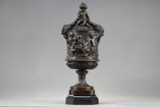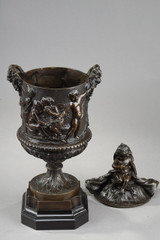A patinated bronze pot in the Louis XVI style, in the manner of Clodion. The main body is decorated with a mythological motif of putti linked by vine branches and bunches of grapes emerging from several cornucopias, themselves held by a central putto perched atop the lid. This putto, the only one with wings, has a serious and focused expression. He stands atop a triton shell, an attribute of Pluto, god of wealth and abundance, while the other putti, nude or lightly draped, appear to be playing. The vase's faceted and molded base is made of black marble and surmounted by a pedestal decorated with acanthus leaves. The date inscribed beneath the vase reads: "February 8, 1891," followed by the name of the medieval town, "Mehun-sur-Hèvre." Second half of the 19th century. Base dimensions: 13.5 x 13.5 cm
Who is Claude Clodion?
Born in Nancy in 1738, Claude Michel (known as Clodion) was the grandson of the sculptor Jacob-Sigisbert Adam. He trained in Paris around 1755 with his uncle Lambert-Sigisbert Adam, and later with the renowned sculptor Pigalle. In 1759, he won first prize for sculpture at the Academy and was admitted to the school of "protégés" (protected students) under the tutelage of Carle van Loo. In 1762, he became a resident at the French Academy in Rome, directed by Charles Natoire. Among his works are "The Entry of the French into Munich" on the Arc de Triomphe du Carrousel and the bas-reliefs on the column of the Grande Armée. He died in his studio at the Sorbonne in 1814, but his Louis XVI style left a lasting mark on subsequent generations.
Circa: 1890
Condition report: Very good condition.
Delivery
Europe: 100 EUR
US/Canada/HK: 200 EUR
Rest of the world: Price upon request
- Reference :
- 3304
- Width :
- 15 (cm)
- Height :
- 43 (cm)
- Depth :
- 15 (cm)
- Era:
- 1890
- Style:
- Louis XVI
- Materials:
- Bronze
















































